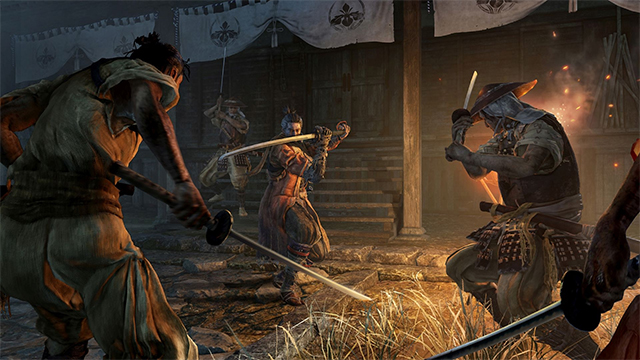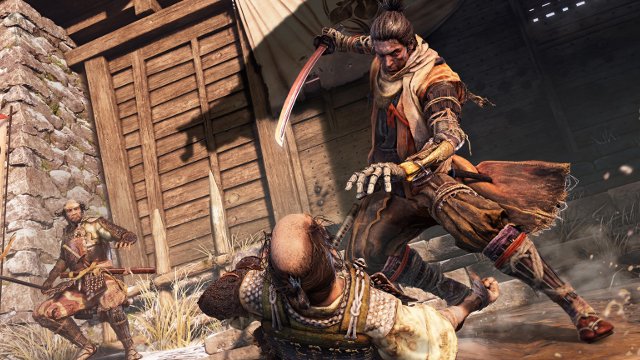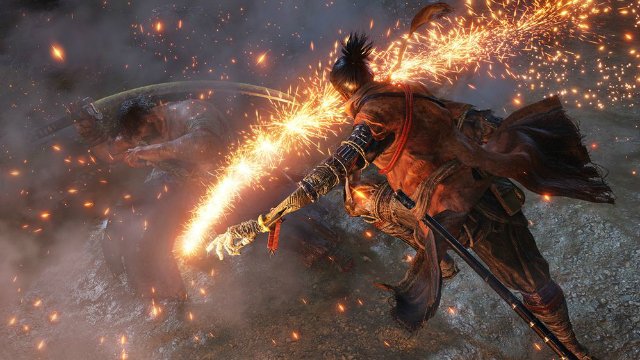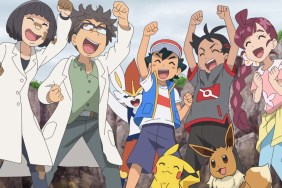Nowadays, it’s hard to dissociate Japanese developer From Software from its beloved Dark Souls series and its critically acclaimed PlayStation 4 exclusive, Bloodborne. The two properties offer thoughtful, challenging combat to those who are willing to die over and over again in order to achieve success. Though Sekiro: Shadows Die Twice will strive to keep in line with the satisfying gameplay the studio has delivered for over a decade, it’ll include elements that set it apart from other titles the studio has crafted in recent memory. The following are some features that Dark Souls and Bloodborne fans may find surprising when they pick up Sekiro on March 22.
How Sekiro differs from Dark Souls and Bloodborne | Stealth

Fans could sneak up on enemies in Dark Souls and Bloodborne in order to gain the upper hand in a fight before it begins. As important as stealth may be in these games, Sekiro further emphasizes it by allowing players to eliminate foes in one hit if they manage to creep close enough without getting noticed. The game encourages users to move around its environments carefully by placing dozens of patrolling enemies in an area at once. Facing a sizable group of these opponents head on is difficult, but fans could even the odds by quietly taking out a few on the sidelines before finishing the rest up close.
The title has already shown off instances in which players will be forced to walk through tall grass and glide across rooftops in order to get by unscathed, as some sections are too open for stealth to be effective. Of course, Dark Souls and Bloodborne fans have the option of eschewing stealth in favor of the challenge the game presents without it. In other words, if players want to make their lives harder than what they need to be, Sekiro is happy to oblige.
How Sekiro differs from Dark Souls and Bloodborne | Weapons and items

When it comes to weapons and items, it’s evident that Sekiro won’t be carrying over many of the RPG elements found in Dark Souls and Bloodborne. For starters, there’s much less room for customization, as fans will always have a katana equipped in their right hand. However, they’ll be able to play around with weapons and items on their artificial left appendage, which is dubbed the Shinobi Prosthetic.
Some attachments showcased so far include an axe, shield, torch, flamethrower, spear, and firecrackers. Fans will also have access to a few projectiles through the arm, including shuriken daggers and kunai knives. Each of these can be utilized in combination with the katana to layer on more damage. For example, players can light their blades on fire using the Shinobi Prosthetic’s torch attachment in order to melt enemies with a few consecutive blows. Discovering which combinations are most effective against specific enemy types helps keep users on their toes and forces them to switch attachments on the fly whenever they’re in a pinch.
While on the topic of combat, Dark Souls and Bloodborne fans may be wondering what Sekiro uses in place of souls and blood echoes. The game’s experience system can be used to improve existing techniques via skill trees and its separate currency system is used to purchase new weapons, items, and various consumables. Though players won’t be able to level up their characters, they will be able to advance their skill sets.
How Sekiro differs from Dark Souls and Bloodborne | Multiplayer

Unlike Dark Souls and Bloodborne, Sekiro won’t include any multiplayer functionality upon release. There’s a good explanation as to why From Software decided to abandon the feature with its next game, as the firm’s marketing and communications manager, Yasuhiro Kitao, explained in an interview early this year that the absence of multiplayer gives the developer better freedom to craft worlds without worrying how multiple players might interact with it. He added that although multiplayer could be added in the future, Sekiro is purely a single-player experience for now.
Souls veterans looking for a challenge may see this as a positive, as other weary warriors won’t be able to leave behind messages warning them of an incoming danger. On the other hand, these fans won’t be able to invade the sessions of unsuspecting players or team up with a buddy to take on a series of grueling chalice dungeons. If Sekiro does eventually incorporate multiplayer elements, it will be interesting to see how it will borrow from From Software’s other work.
How Sekiro differs from Dark Souls and Bloodborne | Death

As its full name indicates, Sekiro heavily revolves around the concept of death. Though Dark Souls and Bloodborne share in this theme, From Software’s newest title sets itself apart by offering players the chance to resurrect themselves immediately after they die. This allows them to finish off the fights they’ve started and sneak up on enemies who’ve assumed you were dead for good. Relying on this neat feature does has its consequences, as using it requires that players give up half of all of their experience points. Additionally, dying often fuels the spread of a sickness called the Dragon Rot, the likes of which can transform Sekiro‘s world and change the behavior of NPCs.
NPCs can stop talking, refuse to sell items, or cease to exist entirely. Mysterious entities called Essences of Rot indicate how many of these characters have been affected and show up automatically in a player’s inventory if he or she finds themselves relying on Sekiro‘s resurrection feature too often.
Death can be both an ally and an enemy in the game. Whenever players die, they have to determine whether it’s best to come back to life or start over from the nearest checkpoint. The title’s ending will vary depending on whatever circumstance they decide best suits their preference.
While there are plenty of elements that separate Sekiro from From Software’s other franchises, it shares a few design ideas with Dark Souls and Bloodborne. For instance, all of these properties include semi-open world environments that encourage players to search for secrets. That’s not to mention each game’s focus on melee combat and their celebration of tough bosses, some of which are optional. It’s obvious that Japan’s Sengoku period is a far cry from Dark Souls‘ medieval landscape and Bloodborne‘s diseased city. Despite this, the DNA that makes up From Software’s prior games can be found in Sekiro if fans are willing enough to trade their swords for katanas.











